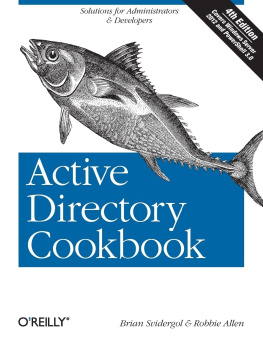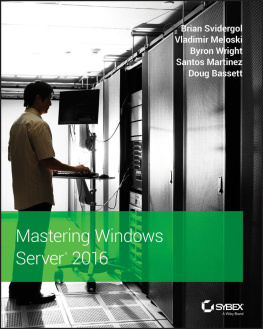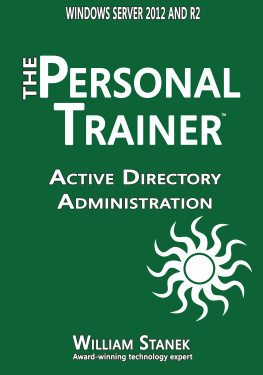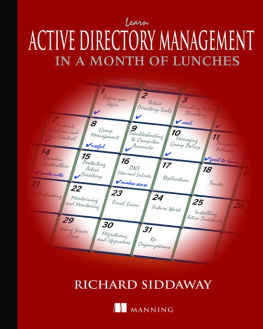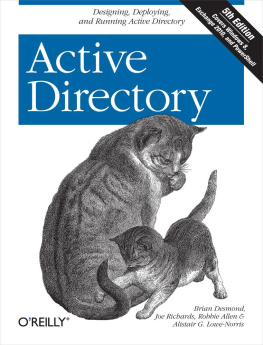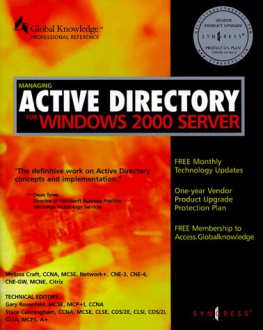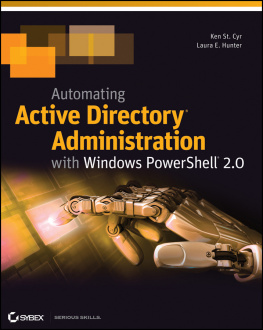| Active Directory Cookbook |
| Brian Svidergol & Robbie Allen |
| OReilly Media, Incorporated (Apr 2013) |
|
| Tags: | Computers, Networking, General, Security, System Administration, Windows Administration |
| Computersttt Networkingttt Generalttt Securityttt System Administrationttt Windows Administrationttt |
Take the guesswork out of deploying, administering, and automating Active Directory.
With hundreds of proven recipes, the updated edition of this popular cookbook provides quick, step-by-step solutions to common (and not so common) problems you might encounter when working with Microsofts network directory service.
This fourth edition includes troubleshooting recipes for Windows Server 2012, Windows 8, and Exchange 2013, based on valuable input from Windows administrators. Youll also find quick solutions for the Lightweight Directory Access Protocol (LDAP), Active Directory Lightweight Directory Services (AD LDS), multi-master replication, DNS, Group Policy, and many other features.
- Manage new AD features, such as the Recycle Bin, Group Managed Service Accounts, and fine-grained password policies
- Work with AD from the command line and use Windows PowerShell to automate tasks
- Remove and create forests, domains, and trusts
- Create groups, modify group scope and type, and manage membership
- Delegate control, view and modify permissions, and handle Kerberos tickets
- Import and export data with LDAP Data Interchange Format (LDIF)
- Synchronize multiple directories and enforce data integrity within a single or multiple stores
- Back up AD, and perform authoritative and non-authoritative restores
Active Directory Cookbook
Brian Svidergol
Robbie Allen
Beijing Cambridge Farnham Kln Sebastopol Tokyo
Download from Wow! eBook
Special Upgrade Offer
If you purchased this ebook directly from oreilly.com, you have the following benefits:
DRM-free ebooksuse your ebooks across devices without restrictions or limitations
Multiple formatsuse on your laptop, tablet, or phone
Lifetime access, with free updates
Dropbox syncingyour files, anywhere
If you purchased this ebook from another retailer, you can upgrade your ebook to take advantage of all these benefits for just $4.99. to access your ebook upgrade.
Please note that upgrade offers are not available from sample content.
Preface
In 1998, when Robbie first became involved with the Microsoft Windows 2000 Joint Development Program (JDP), very little data was available on Active Directory (AD). In the following months, and even after the initial release of Windows 2000, there were very few books or white papers to help early adopters of Active Directory get started. And some of the information that had been published was often inaccurate or misleading. Many early adopters had to learn by trial and error. As time passed, a greater number of informative books were published, which helped fill the information gap.
By the end of the second year of its release, there was an explosion of information on Active Directory. Not only were there more than 50 books published, but Microsoft also cleaned up its documentation on MSDN and its AD website. Now those sites have numerous white papers, many of which could serve as mini booklets. Other websites have popped up as well that contain a great deal of information on Active Directory. With Windows Server 2008, Windows Server 2008 R2, and Windows Server 2012, Microsoft has taken its level of documentation a step further. Extensive information on Active Directory is available directly from any Windows Server 2008 or 2012 computer in the form of the built-in help information. So, with all this data available on Active Directory in the form of published books, white papers, websites, and even from within the operating system, why would you want to purchase this book?
In the summer of 2002, Robbie was thumbing through Tom Christiansen and Nathan Torkingtons Perl Cookbook (OReilly), looking for help with an automation script that he was writing for Active Directory. It just so happened that there was a recipe that addressed the specific task he was trying to perform. In Cookbook parlance, a recipe provides instructions on how to solve a particular problem. We thought that since Active Directory is such a task-oriented environment, the Cookbook approach might be a very good format. After a little research, Robbie found there were books (often several) on nearly every facet of Active Directory, including introductory books, design guides, books that focused on migration, programming books, and reference books. The one type of book that he didnt see was a task-oriented how to book, which is exactly what the Cookbook format provides. With this was born the first edition of Active Directory Cookbook , covering Active Directory tasks in Windows 2000 and Windows Server 2003 Active Directory.
In 2005 and again in 2008, Laura E. Hunter revised the already popular Active Directory Cookbook to include an updated range of automation options, including the use of command-line tools and scripts that had been created by active members of the Directory Services community in the years since AD was first introduced.
Based on our experience, hours of research, and nearly a decade of hanging out on Active Directory newsgroups and mailing lists, weve compiled more than 500 recipes that should answer the majority of How do I do X ? questions one could pose about Active Directory. And just as in the Perl community, where the Perl Cookbook was a great addition, we believe Active Directory Cookbook , Fourth Edition, will also be a great addition to any Active Directory library.
Who Should Read This Book?
As with many of the books in the Cookbook series, Active Directory Cookbook , Fourth Edition, can be useful to anyone who wants to deploy, administer, or automate Active Directory. This book can serve as a great reference for those who have to work with Active Directory on a day-to-day basis. For those without much programming background, the command-line and PowerShell solutions are straightforward and provide an easy way to automate repetitive administrative tasks for any administrator.
The companion to this book, Active Directory , Fifth Edition, by Brian Desmond et al. (OReilly), is a great choice for those wanting a thorough description of the core concepts behind Active Directory, how to design an Active Directory infrastructure, and how to automate that infrastructure using Active Directory Service Interfaces (ADSI) and Windows Management Instrumentation (WMI). Active Directory , Fifth Edition, does not necessarily detail the steps needed to accomplish every possible task within Active Directory; that is more the intended purpose of this book. These two books, along with the supplemental information referenced within each, should be sufficient to answer most questions you have about Active Directory.
Whats in This Book?
This book consists of 21 chapters. Here is a brief overview of each chapter:
Sets the stage for the book by covering where you can find the tools used in the book, PowerShell issues to consider, and where to find additional information.
Covers how to create and remove forests and domains, update the domain mode or functional levels, create different types of trusts, and perform other administrative trust tasks.

